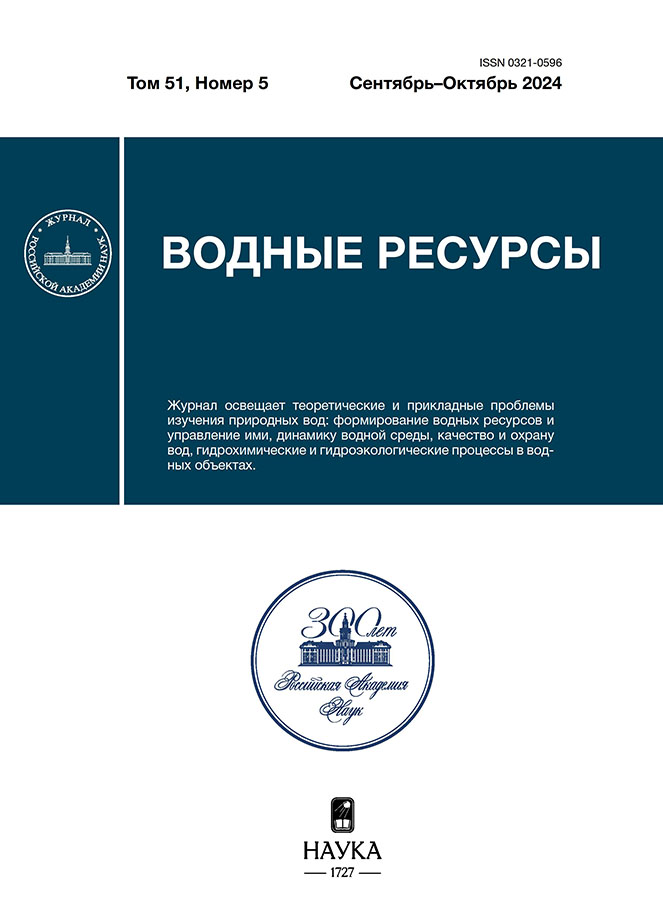A numerical hydrodynamic model of a long segment of the Ural River and its application to assessing the inundation risk of residential areas by floods and breakthrough waves
- Authors: Belikov V.V.1, Borisova N.M.1, Vasil’eva E.S.1, Glotko A.V.1,2, Fedorova T.A.1
-
Affiliations:
- Water Problems Institute, Russian Academy of Sciences
- Moscow State University of Civil Engineering (MGSU)
- Issue: Vol 51, No 5 (2024)
- Pages: 608-618
- Section: Гидроэкологическое состояние бассейна р. Урал и возможность устойчивого управления его водными ресурсами
- URL: https://journals.eco-vector.com/0321-0596/article/view/684578
- DOI: https://doi.org/10.31857/S0321059624050063
- EDN: https://elibrary.ru/VXRZKQ
- ID: 684578
Cite item
Abstract
A numerical hydrodynamic model was constructed for the segment of the Ural River from the Iriklinskoe Reservoir (inclusive) to a site 30 km downstream of the Sakmara River inflow; therefore, the total length of the model reach was >700 km. To reduce the time of model development and to accelerate the calibration and variant calculations, the segment was divided into three successive parts of the channel, interacting through consistent boundary conditions. The simulation is carried out with the use of a domestic highaccuracy software package STREAM 2D CUDA, taking into account abrupt changes in bottom elevation and multifractional soil composition. The model was calibrated for constant water discharges. Calculations were carried out for a spring flood with an exceedance probability of 1% and a breakthrough wave of the Iriklinskii Hydropower System under two scenarios. Maximal water levels, depths, and inundation zones were obtained. An effect of a many-time increase in the steepness of the leading front of the flood wave within the domain was revealed.
Full Text
About the authors
V. V. Belikov
Water Problems Institute, Russian Academy of Sciences
Author for correspondence.
Email: belvv@bk.ru
Russian Federation, Moscow, 119333
N. M. Borisova
Water Problems Institute, Russian Academy of Sciences
Email: belvv@bk.ru
Russian Federation, Moscow, 119333
E. S. Vasil’eva
Water Problems Institute, Russian Academy of Sciences
Email: vasilevaes@yandex.ru
Russian Federation, Moscow, 119333
A. V. Glotko
Water Problems Institute, Russian Academy of Sciences; Moscow State University of Civil Engineering (MGSU)
Email: vasilevaes@yandex.ru
Russian Federation, Moscow, 119333; Moscow, 129337
T. A. Fedorova
Water Problems Institute, Russian Academy of Sciences
Email: belvv@bk.ru
Russian Federation, Moscow, 119333
References
- Алексюк А.И., Беликов В.В. Моделирование течений мелкой воды с областями обмеления и разрывами дна // Журн. вычислительной математики и математической физики. 2017. Т. 57 (2). С. 316–338.
- Алексюк А.И., Беликов В.В. Свидетельство 2017660266 Российская Федерация. Свидетельство о государственной регистрации программ для ЭВМ. Программный комплекс STREAM 2D CUDA для расчета течений, деформаций дна и переноса загрязнений в открытых потоках с использованием технологий Compute Unified Device Architecture (на графических процессорах NVIDIA). № 2017617252. Опубл. 20.09.2017. Реестр программ для ЭВМ. 1 с.
- Беликов В.В. Вычислительный комплекс “TRIANA” – генератор сеток треугольных конечных элементов в произвольных плоских областях. ГосФАП СССР. П007705. 1984.
- Беликов В.В., Алексюк А.И. Модели мелкой воды в задачах речной гидродинамики. М.: РАН, 2020. 346 с.
- Беликов В.В., Алексюк А.И., Борисова Н.М., Васильева Е.С., Глотко А.В. Особенности численного гидродинамического моделирования протяженных участков рек // Вод. ресурсы. 2023. Т. 50. № 4. С. 367–384.
- Беликов В.В., Алексюк А.И., Борисова Н.М., Васильева Е.С., Глотко А.В. Численное моделирование течений и деформаций дна в бьефах гидроузлов. М.: ЯНУС-К, 2023. 304 с.
- Беликов В.В., Алексюк А.И., Васильева Е.С. Численное моделирование волн прорыва. М.: РАН, 2023. 301с.
- Беликов В.В., Милитеев А.Н., Кочетков В.В. Свидетельство 2001610638 об официальной регистрации программы для ЭВМ. Комплекс программ для расчета волн прорыва (БОР). № 2001610454. 2001. Реестр программ для ЭВМ. 1 с.
- Беликов В.В., Семенов А.Ю. Метод Годунова с модификацией Колгана для численного решения двумерных уравнений мелкой воды // Тр. X конф. молодых ученых Моск. физ.-техн. ин-та (1985). Деп. в ВИНИТИ Ч. 1. № 5983-85 Деп. с. 179–214.
- Беликов В.В., Семенов А.Ю. Численный метод распада разрыва для решения уравнений теории мелкой воды // Журн. вычисл. математики и математ. физики. 1997. Т. 37. № 8. С. 1006–1019.
- Васильева Е.С., Беликов В.В. Численное моделирование каскадной гидродинамической аварии на Верхнеуральской и Магнитогорской плотинах // Гидротехн. стр-во. 2023. № 8. С. 36–44.
- Глобальная цифровая модель поверхности ALOS “ALOS World 3D-30m (AW3D30)” https://www.eorc.jaxa.jp/ALOS/en/dataset/aw3d30/aw3d30_e.htm
- Декларация безопасности ГТС Ириклинской ГЭС. Рег. № 22-22 (05) 0030-00-ГЭС. Утв. 21 декабря 2021 г. п. Энергетик, Оренбургская обл., 2021.
- Основные положения правил использования водных ресурсов Ириклинского водохранилища на р. Урале. М.: Мин-во мелиорации и водного хозяйства РСФСР, Упр. по регулированию использования вод. ресурсов, 1973.
- Проект правил использования водных ресурсов Верхне-Уральского, Магнитогорского и Ириклинского водохранилищ. Екатеринбург: СевКавНИИВХ, 2013 г.
- Aleksyuk A.I., Belikov V.V. The uniqueness of the exact solution of the Riemann problem for the shallow water equations with discontinuous bottom // J. Comp. Phys. 2019. V. 390. P. 232–248. https://doi.org/10.1016/j.jcp.2019.04.001
- Aleksyuk A.I., Malakhov M.A., Belikov V.V. The exact Riemann solver for the shallow water equations with a discontinuous bottom // J. Comp. Phys. 2022. V. 450. P. 110801. https://doi.org/10.1016/j.jcp.2021.110801
Supplementary files






















